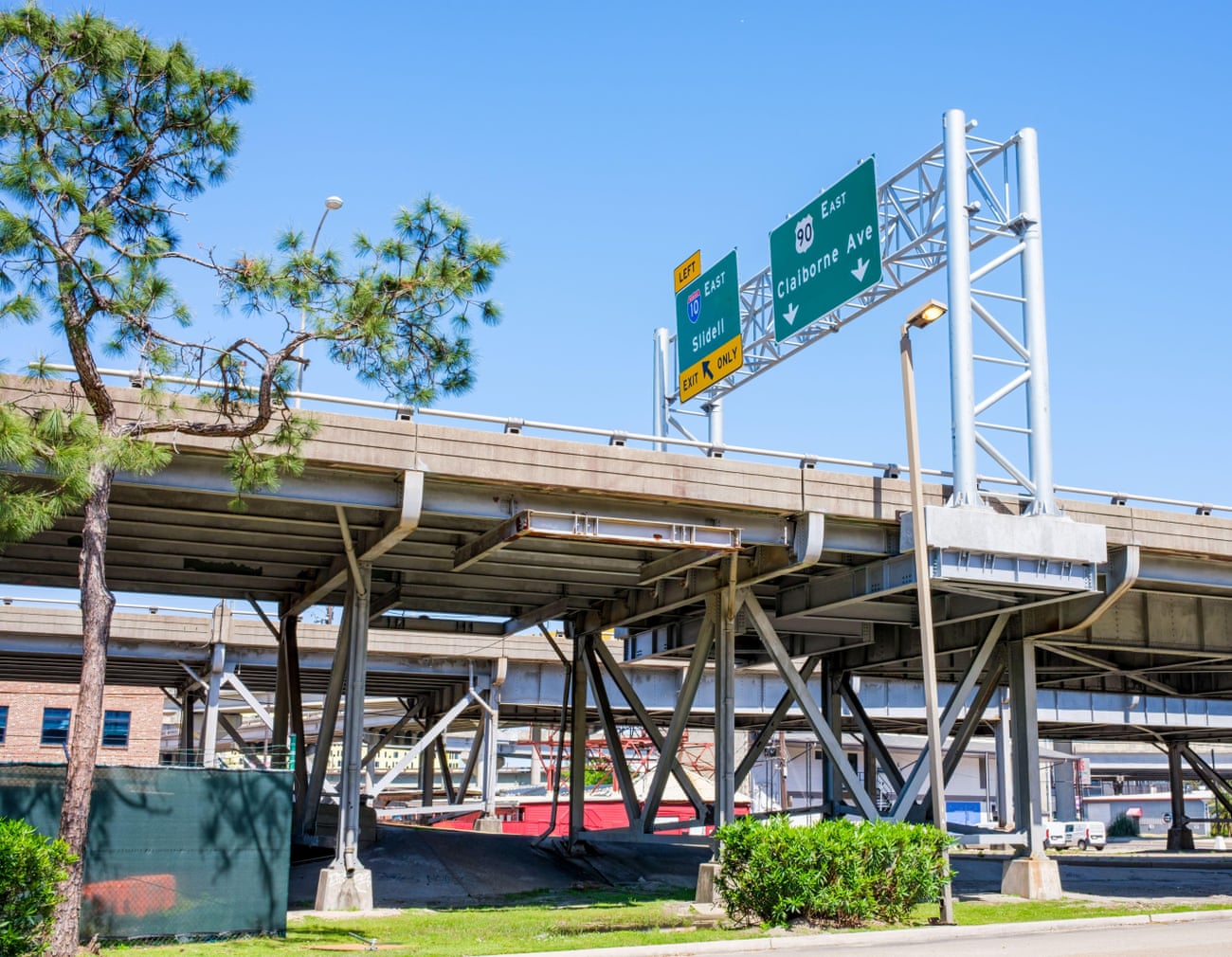Amy Stelly can see the on-ramp for the Claiborne Expressway from the second-floor porch of her childhood home, a block and a half away from the highway. She lives in Treme, a historic Black neighborhood in New Orleans. For decades, the highway has devastated her neighborhood. Stelly is an urban designer and co-founder of the Claiborne Avenue Alliance, which is advocating for its removal.
“Claiborne has not been maintained at all,” she says of the highway on the brink of disrepair. “Not only do we have the dire economics, we have the actual physical atrocity. It’s dirty. It’s loud. It’s polluted.”
So, when the US transportation department recently announced a $1bn five-year pilot program to aid communities racially segregated by US government-sponsored highway projects, Stelly responded with a mix of optimism and tempered expectations. Joe Biden singled out the Claiborne Expressway when the program, known as Reconnecting Communities, was first announced.
Experts and advocates question whether the initial investment is enough to reverse the devastation in Black neighborhoods in the name of connection. The amount unveiled by the transportation department is a far cry from the original $20bn proposed. But advocates agree that it’s an unprecedented and welcome step in pursuit of highway reparations.
“It’s the beginning, not the end, of the process,” Stelly told the Guardian.
Under the department’s program, announced in late June, cities, states, non-profits, tribal governments and city planning organizations can seek grants to conduct traffic studies, encourage public input on highway plans and pursue other planning activities “in advance of a project to remove, retrofit, or mitigate an existing eligible facility to restore community connectivity”. Communities can apply for $195m in grants in the first year, $50m for planning studies, the remainder for capital construction.
“[W]e can’t ignore the basic truth that some of the planners and politicians behind those projects built them directly through the heart of vibrant, populated, communities – sometimes in an effort to reinforce segregation,” the transportation secretary, Pete Buttigieg, said during a speech announcing the program in Birmingham, Alabama. “While the burden is often greatest for communities of color, Americans today of every background are paying the price of these choices.”
![North Claiborne Avenue Overpass: Union Station Attached text: North Claiborne overpass for Press Street yards of New Orleans and Northeastern railroad is nearing its final stages. The work was started April 1. It is only a few blocks away from sister-project, the North Galvez overpass. In addition to speeding flow of traffic, overpasses and underpasses eliminate danger of rail crossing accidents. October 12, 1950 [Photography by Industrial Aerial Photos]](https://i.guim.co.uk/img/media/c240f7fc850e977a2042555870c974cbe5945a98/0_0_650_541/master/650.jpg?width=620&quality=85&fit=max&s=c2209514c17040088d877bd174bc7449)
The wreckage wrought by America’s highways began after the second world war, when President Franklin D Roosevelt approved the construction of 40,000 miles of interstate highways. By the time President Dwight Eisenhower took office, in 1953, just over 6,000 miles had been built. That accelerated after Eisenhower signed the Federal Aid Highway Act of 1956, which authorized $25bn to construct a “modern, interstate highway system”.
Deborah Archer, co-faculty director of New York University’s Center on Race, Inequality, and the Law, says that the federal program “destroyed vibrant Black communities” and “cut the heart and soul out of many Black communities by taking their homes, churches and schools”.
Back then, the US government provided little assistance to displaced communities, forcing people farther away from economic opportunity and toward already segregated and financially disenfranchised communities. “Our highway system was a physical realization of the racialized norms and values in our country. So much of that was really intentional,” says Archer, who wrote a paper on the historical damage highways have done to Black communities.
By the time the Claiborne Expressway opened in 1968, more than 500 houses had been cleared, according to the Congress for the New Urbanism, which supports “people-centered places”. The oak trees that lined Claiborne Avenue were replaced with concrete.
“It’s only right that the federal government seeks to correct the mistake that it made decades ago. So I applaud them for doing it. But we have to follow through,” Stelly says. “The key is to continue funding the efforts once this $1bn is exhausted, because we all know that it’s not going to get us to the final goal.”
The Freeway Fighters Network, a coalition supported by the Congress for the New Urbanism (CNU), estimated that more than 70 projects are under way to remove or revamp highways and prevent expansions throughout the US. The group started in 2019 when activists lobbied lawmakers in Washington to support infrastructure legislation. It has since grown to an informal network that meets regularly on Zoom to discuss their projects and share strategies.
Ben Crowther, who led CNU’s advocacy for the reconnecting communities program, says it will take years of sustained funding to see how these highway removal campaigns play out. He says the funding is “not going to solve the inequities or the problems that we’ve created with the highway system in one fell swoop”. Transportation department officials have estimated that the money could only support from three to 15 projects involving demolition and construction.
What’s unique about the new federal program, says Crowther, now advocacy manager of AmericaWalks, is that it gives non-profit organizations the chance to pursue funding to study what highway removal means for the surrounding community, which state transportation officials typically don’t consider. He said it often takes public pressure to inspire change, like what happened during “freeway revolts” in the 1960s and 1970s when communities blocked proposed highway projects.
It’s ultimately up to state lawmakers and governors to approve project funding, a prospect that often leads to even further delays, leading state transportation agencies to pursue this new pot of funding.
In St Paul, Minnesota, the group ReConnect Rondo has advocated for turning a stretch of Interstate 94, which cuts through the historically Black neighborhood of Rondo, into a 21-acre land bridge over the freeway.
Keith Baker, the group’s executive director, described the Rondo neighborhood, where his family often visited, as “a small town”. But like freeways across the country, Interstate 94, built between 1956 and 1968, “tore out the social, economic, environmental and cultural fabric of the community”, he says. More than 300 businesses closed and more than 700 houses were demolished, according to the group. Baker estimates that those houses represented at least $157m in lost wealth. “That equity never got realized for people who own those homes,” he says. “Before the freeway came through, Rondo was the enterprise district of the African American community. The freeway ultimately destroyed them.”
Baker says his group plans to pursue grant funding to conduct a study on what their proposal would mean for the surrounding areas. The land bridge, he says, can bring houses and businesses back to the neighborhood, cultivating a green gathering space for the surrounding neighborhoods. A feasibility study releasedin June 2020 shows that the effort, which could cost an estimated $458m, could attract 1,800 jobs.

Deborah Archer, who also serves as president of the American Civil Liberties Union, cautions that the transportation department funds, though unprecedented in scope and intent, would not fully rectify the damage in Black communities caused by the loss of wealth. Future removal projects need to ensure that anti-displacement protections are in place to guard families living by highways and ensure they are not replaced in the name of economic investment.
“The conditions that the highways created have been built over decades,” Archer says. “It’s not going to be easy to weave back communities that were torn apart by these highways. The funding recognizes that rebuilding is not just about the absence of these physical dividers. It’s even more about creating the conditions for a community to flourish.”
For Stelly, the funding would give the Claiborne Coalition the opportunity to conduct an updated study to see how a highway removal project would affect the surrounding community. It offers a chance to gather community input on what the future could hold, to examine ways to ensure people are not displaced by future highway projects and to forecast the economic impact of removing the highway.
Stelly reflected on what the community her family has called home for decades lost: the convenience stores, the small family businesses, the neighbors. A funeral home is one of the few businesses that survived the aftermath of the highway’s construction.
“When my family bought this property almost 70 years ago, this neighborhood was very different. It was beautiful. It was tree-lined. It had a host of professional services and had places to buy fresh food. It was clean,” Stelly says. “I would like to receive reparations for what my family has lost because when they made this initial investment, they didn’t do it thinking that it was going to be derailed.”




